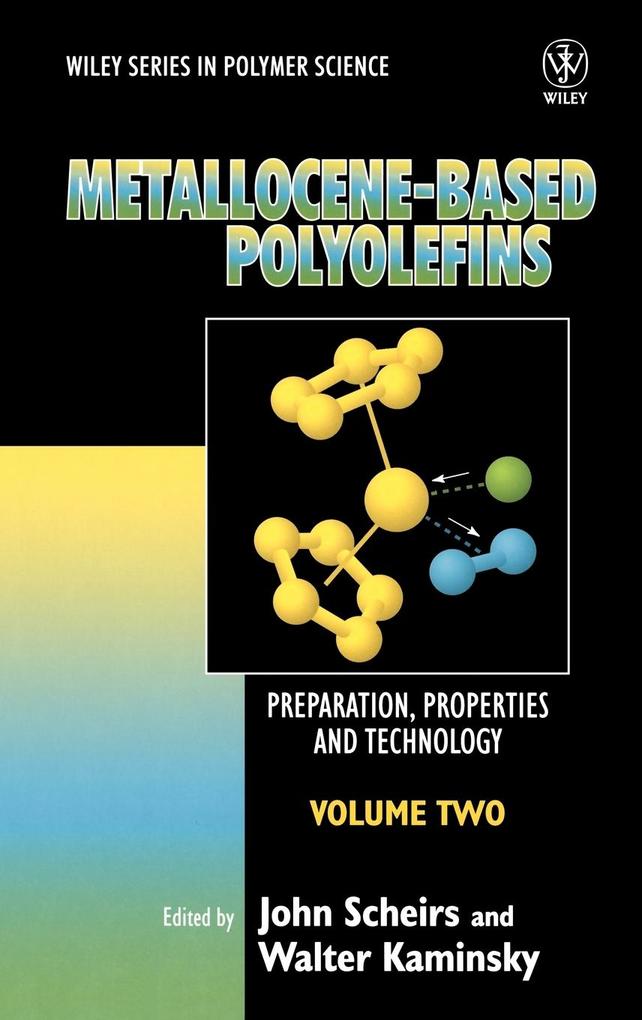
Zustellung: Di, 17.06. - Sa, 21.06.
Versand in 2 Wochen
VersandkostenfreiBestellen & in Filiale abholen:
The manufacture of polyolefins by metallocene catalysts represents a revolution in the polymer industry. The first patent for a metallocene catalyst was filed in 1980 but it has been the last five years that have seen a dramatic increase in the volume of research into metallocenes and the maturing of metallocene technology. With contributions from leading experts from the US, Canada, Italy, Scandinavia, Germany and Japan, Metallocene-based Polyolefins gives comprehensive coverage of all areas of metallocene technology: catalyst structure, comonomer incorporation, polymerization mechanisms and conditions, reactor configurations, special properties, rheological and processing behaviour, comparison with conventional polyolefins and fields of application. An essential book for plastics engineers, polymer chemists, physicists, materials scientists and all those working in the plastics manufacturing and processing industries.
Inhaltsverzeichnis
MECHANISTIC ASPECTS OF METALLOCENE CATALYSTS.
Molecular Modeling Studies on Stereospecificity andRegiospecificity of Propene Polymerizations by Metallocences (P. Corradini, et al.).
Chiropicity of Metallocene Catalysts and Propene Polymerization (G. Di Silvestro).
Stereospecific Polymerization of Chiral -Olefins (A. Zambelli).
Computational Modeling of Single-site Polymerization Catalysts (T. Woo, et al.).
CYCLOOLEFINS, DIENES AND FUNCTIONALIZED OLEFINPOLYMERIZATION.
Homo- and Copolymerization of Cycloolefins by Metallocene Catalysts(W. Kaminsky & M. Arndt-Rosenau).
Metallocene Catalysts for 1, 3-Diene Polymerization (L. Porri, etal.).
New Functionalized Olefin Copolymers Synthesized by Metallocenesand Novel Organometallic Catalysts (B. Lofgren & J. Seppala).
PLASTOMERS AND ELASTOMERS.
Constrained Geometry Single-site Catalyst Technology Elastomers andPlastomers for Impact Modifications and Automotive Applications (K. Sehanobish, et al.).
Structure, Properties and Applications of Polyolefin ElastomersProduced by Constrained Geometry Catalysts (T. Ho & J. Martin).
Packaging Applications Using Enhanced Polyethylenes and PolyolefinPlastomers Produced by Contrained Geometry Single-site Catalysts(K. Koch, et al.).
Measurement, Mathematical Modeling and Control of Distribution ofMolecular Weight, Chemical Composition and Long-chain Branching ofPolyolefins Made with Metallocene Catalysts (J. Soares & A. Penlidis).
STYRENE POLYMERIZATION.
Structure, Properties and Applications of Ethylene-StyreneInterpolymers (M. Guest, et al.).
Metallocene-Based Reactive Polyolefin Copolymers Containingp-Methylstyrene (T. Chung).
COMMERCIAL METALLOCENE POLYMERIZATION METHODS.
Applications of Metallocene Catalysts to Large-scale Slurry LoopReactors (D. Fahey, et al.).
Multi-catalyst Reactor Granule Technololgy for the Production ofMetallocene Polymers (J. Haylock, et al.).
Metallocene Catalyst Technology in a Bimodal Polymerization Process(H. Knuuttila, et al.).
RHEOLOGY AND PROCESSING OF METALLOCENE-BASED POLYMERS.
Rheological Properties of Metallocene-catalyzed Polyolefins in theMelt and Solid States and Comparison with Conventional Polyolefins(J. Carella & L. Quinzani).
Rheology and Processing of Metallocene-based Polyolefins (F. Eckstein, et al.).
Melt-rheological Characteristics of Metallocene-catalyzedPolyethylenes (D. Rohlfing & J. Janzen)
Extrusion Characteristics of Metallocene-based Polyolefins (C. Cheng).
APPLICATIONS OF METALLOCENE-BASED POLYOLEFINS.
Film Applications for Metallocene-based Propylene Polymers (A. Mehta, et al.).
Medical Applications of Metallocene-catalyzed Polyolefins (R. Portnoy & J. Domine).
Constrained Geometry-catalyzed Polyolefins in Durable and Wire andCable Applications (S. Betso, et al.).
Production and Use of Metallocene-based Polyethylene in RotomoldingApplications (A. Fatnes, et al.).
Index.
Molecular Modeling Studies on Stereospecificity andRegiospecificity of Propene Polymerizations by Metallocences (P. Corradini, et al.).
Chiropicity of Metallocene Catalysts and Propene Polymerization (G. Di Silvestro).
Stereospecific Polymerization of Chiral -Olefins (A. Zambelli).
Computational Modeling of Single-site Polymerization Catalysts (T. Woo, et al.).
CYCLOOLEFINS, DIENES AND FUNCTIONALIZED OLEFINPOLYMERIZATION.
Homo- and Copolymerization of Cycloolefins by Metallocene Catalysts(W. Kaminsky & M. Arndt-Rosenau).
Metallocene Catalysts for 1, 3-Diene Polymerization (L. Porri, etal.).
New Functionalized Olefin Copolymers Synthesized by Metallocenesand Novel Organometallic Catalysts (B. Lofgren & J. Seppala).
PLASTOMERS AND ELASTOMERS.
Constrained Geometry Single-site Catalyst Technology Elastomers andPlastomers for Impact Modifications and Automotive Applications (K. Sehanobish, et al.).
Structure, Properties and Applications of Polyolefin ElastomersProduced by Constrained Geometry Catalysts (T. Ho & J. Martin).
Packaging Applications Using Enhanced Polyethylenes and PolyolefinPlastomers Produced by Contrained Geometry Single-site Catalysts(K. Koch, et al.).
Measurement, Mathematical Modeling and Control of Distribution ofMolecular Weight, Chemical Composition and Long-chain Branching ofPolyolefins Made with Metallocene Catalysts (J. Soares & A. Penlidis).
STYRENE POLYMERIZATION.
Structure, Properties and Applications of Ethylene-StyreneInterpolymers (M. Guest, et al.).
Metallocene-Based Reactive Polyolefin Copolymers Containingp-Methylstyrene (T. Chung).
COMMERCIAL METALLOCENE POLYMERIZATION METHODS.
Applications of Metallocene Catalysts to Large-scale Slurry LoopReactors (D. Fahey, et al.).
Multi-catalyst Reactor Granule Technololgy for the Production ofMetallocene Polymers (J. Haylock, et al.).
Metallocene Catalyst Technology in a Bimodal Polymerization Process(H. Knuuttila, et al.).
RHEOLOGY AND PROCESSING OF METALLOCENE-BASED POLYMERS.
Rheological Properties of Metallocene-catalyzed Polyolefins in theMelt and Solid States and Comparison with Conventional Polyolefins(J. Carella & L. Quinzani).
Rheology and Processing of Metallocene-based Polyolefins (F. Eckstein, et al.).
Melt-rheological Characteristics of Metallocene-catalyzedPolyethylenes (D. Rohlfing & J. Janzen)
Extrusion Characteristics of Metallocene-based Polyolefins (C. Cheng).
APPLICATIONS OF METALLOCENE-BASED POLYOLEFINS.
Film Applications for Metallocene-based Propylene Polymers (A. Mehta, et al.).
Medical Applications of Metallocene-catalyzed Polyolefins (R. Portnoy & J. Domine).
Constrained Geometry-catalyzed Polyolefins in Durable and Wire andCable Applications (S. Betso, et al.).
Production and Use of Metallocene-based Polyethylene in RotomoldingApplications (A. Fatnes, et al.).
Index.
Produktdetails
Erscheinungsdatum
21. Januar 2000
Sprache
englisch
Auflage
Volume 2 edition
Seitenanzahl
600
Herausgegeben von
John Scheirs, Walter Kaminsky
Verlag/Hersteller
Produktart
gebunden
Gewicht
1059 g
Größe (L/B/H)
240/161/36 mm
ISBN
9780471999126
Bewertungen
0 Bewertungen
Es wurden noch keine Bewertungen abgegeben. Schreiben Sie die erste Bewertung zu "Metallocene-Based Polyolefins" und helfen Sie damit anderen bei der Kaufentscheidung.









